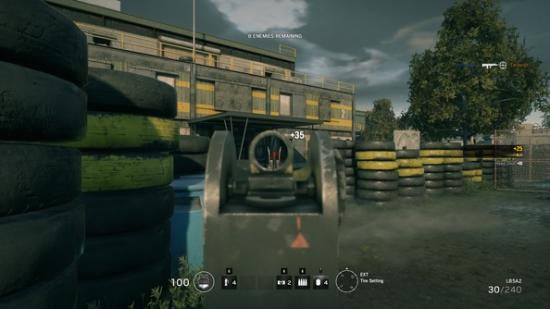Update 1 Dec, 2015: Rainbox Six Siege is now out in the wild and avalable for purchase, so it’s high time to examine the quality of Ubisoft Montreal’s PC port and ensure you get that silky smooth 60fps a game such as this requires. Some users are having problem launching the game from Steam though, which seems to be caused by a compatibility issue with UPlay. Until the official sources fix it, here’s how to get the game running, courtesy of Steam user Vipr:
“1. Copy the Steam game folder “Tom Clancy’s Rainbow Six Siege” located in
C:\Program Files\Steam\steamapps\common\Tom Clancy’s Rainbow Six Siege
And copy it somewhere for the time being.
2. Now go back and in steam Right click on the game and Delete Local content (This is why we made a copy)
3. Now place the folder back into the same location it was in and then go into the Folder and open the .EXE and Steam will pop up asking you to reinstall the game
4.Click Okay and Steam should say something along the lines of “Discovering Existing Files” then your doing it right 🙂
Now after it is done click Play and you’re all set.”
Original story 30 Nov, 2015: Ubisoft Montreal have once again donned the goggles and kevlar, revamping Rainbow Six for the post CS:GO gamer. But never mind the particulars of its tactical cat-and-mouse multiplayer FPS stylings, or the vast array of online functionality. With the game now out, all you really want to know is: how does it run? Smooth 60fps gameplay is borderlane mandatory in multiplayer shooters, so analysing R6 Siege’s engine performance isn’t simply an excercise in nitpicking or graphics card elitism. You need that 60fps, and we’ll show you how easily it’s obtained.
Tested on a Intel i7-2600K @4.7 GHz, 16 GB of RAM, Asus ROG Matrix GeForce GTX 980 ti, Windows 10.
R6 Siege’s chief opponent is, of course, Counter-Stike: Global Offensive, a game you can get running at a smooth 1080p/60fps on your watch. It’s also a fairly simple game in terms of visual effects, so on paper Ubisoft Montreal’s job is simple: make it look better than CS:GO, but keep the system demands reasonable. And right enough, the low barrier for entry in the game’s minimum and recommended system specs reflect that mindset.
However as with Ubisoft’s other recent major release, Assassin’s Creed Syndicate, there’s a good deal of scalability within the engine so you can really give your GPU a hard time in the name of imperceptibly ‘better’ anti-aliasing. It should be noted that no matter how far you slide the graphics sliders, the game never magically takes on the appearance of that E3 2014 reveal trailer. The hostage animation, surface reflection quality, debris density and detail are all clearly of a lower fidelity in the final game, but unfortunately we’re becoming used to seeing that in triple-A development.
Siege does still have impressive environmental destruction in its repertoire though, likewise impressive explosion and smoke effects. That comes as a result of Ubisoft’s Anvil Next game engine and Real Blast destruction tech joining forces. Anvil Next powered the last two Assassin’s Creeds, with mixed results (although Syndicate runs much better on PC than Unity). Real Blast assigns different destuction properties to different materials; wood splinters when it’s shot at, drywall throws up chalky powder, and bullet penetration is modelled in detail to affect velocity and direction. Also, it looks really nice.
Encouragingly, the overall fidelity level remains quite high even at low graphical settings. And the best news of all: it has an in-game benchmark so you can assess your system’s performance without having to run around a public map trying to replicate the exact way you got shot last time for an accurate fps readout. The good times are here to stay, frame rate neurotics!
I’m testing Siege out on a mixture of old and new hardware – my Core i7 2600K CPU is no longer bleeding-edge tech, but coupled with an overclocked Asus Matrix GTX 980 ti it’s unlikely to sweat it. The panel I’m using for testing is Asus’sROG Swift PG279Q, with a native resolution of 2560 x 1440, NVIDIA G-Sync enabled, and an ‘overclocked’ refresh rate of 165Hz. It’s a hardware array capable of great things, but the game’s performance analysis tool doesn’t seem confident. By default it sets the overall graphics settings level to ‘ultra’ – fine, good start – but the output resolution to 1920 x 1080. You may want to delve into the visual settings yourself and do some manual tweaks, if you don’t do that by default. Here’s what you’ll find when you do:
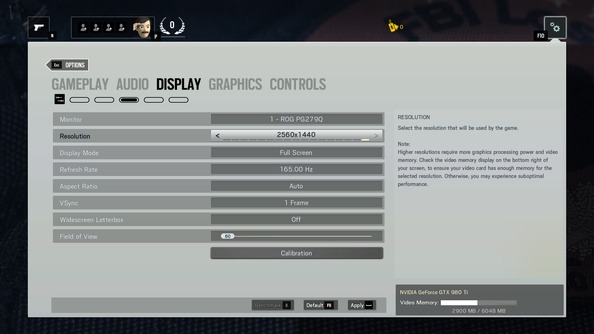
It’s a very similar array of options to that of Assassin’s Creed Syndicate, which you’d expect as the two games share that much-improved Anvil Next engine. As such, the ‘display’ options give you the usual: resolution, refresh rate, v-sync and FOV. The latter’s inclusion is practically essential for a multiplayer FPS so kudos there, Ubi. It’s nice to have two different v-sync settings too: one that syncs every frame, and one every other frame, in case your GPU can’t match the refresh rate. Given that I’m gaming with 165Hz, that’s useful to me.
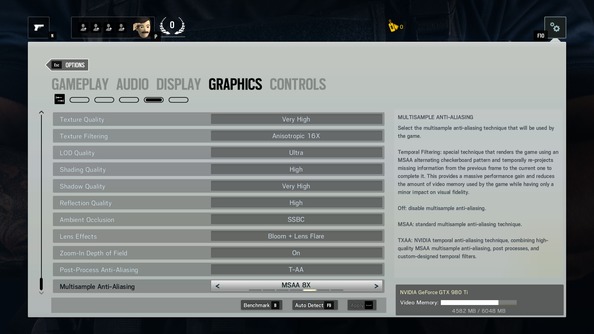
Here in the more in-depth ‘graphics’ options menu, Siege again takes a similar complexion to AssCreed Syndicate. The most welcome return vistor is that VRAM usage meter in the bottom right, giving you an indication of exactly how much stress you’re putting on your GPU with any particular combination of settings. The only combination I found that tipped the 4GB mark was the ultra preset + MSAA 8X, which happened to absolutely slay my frame rate down to the 30fps mark. Luckily that’s the most taxing AA setting by far, and the least resource hungry temporal filtering option eradicates the jaggies very well indeed. It “renders the game using an alternating MSAA checkboard pattern and temporarily reprojects missing information from the previous frame,” according to Siege’s own in-menu guide.
Temporal filtering is a real boon in Siege – if you’re looking to boost your frame rate, set your AA to this. The difference between options here is minimal, but the performance yields are huge.
One other interesting graphical feature before we explore the graphical presets and the fps performance gaps between them – SSBC. This is Ubisoft’s own ambient occlusion technology, an alternative to NVIDIA’s HBAO+. It’s worked wonders in previous Ubi titles, particularly Far Cry 4, and here in Siege it’s once again the better option for both performance and image quality. The frame rate gains are marginal at 2-3 fps on my test system, but will be more pronounced on less powerful GPUs. Meanwhile the shadows and image depth is slightly improved using SSBC over HBAO+. To my eyes, at least.
Without further ado though, let’s look at how Siege meets the eye on its various graphical presets – and thanks to the in-game benchmarks, what kind of performance difference exists between them. Take it away, ultra:
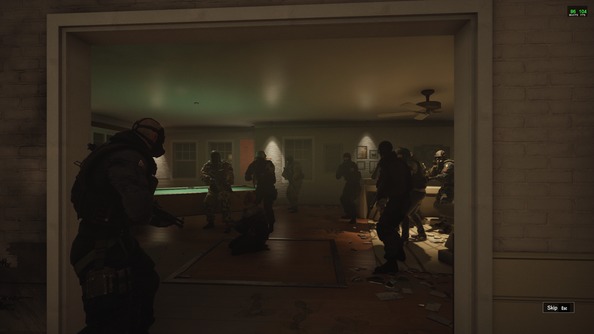
Interestingly Siege’s ultra preset favours the tmeporal filtering AA technique over MSAA or TXAA, which keeps overall performance levels quite high. If you want to tax your system for the sake of it – or if your bionic eyes can actually tell the difference between techniques – be my guest and cycle them to taste. My system ate up the benchmark with an average frame rate of 104, a high of 167, and a low of 63. There’s no frame cap in Siege’s graphics menus so you’ll need to lean on v-sync options or a third-party fps limiter for rock-solid 60/90fps gameplay. Particularly here in ultra territory, where the explosions do cause some frame dips. Onwards to the ‘very high’ preset:
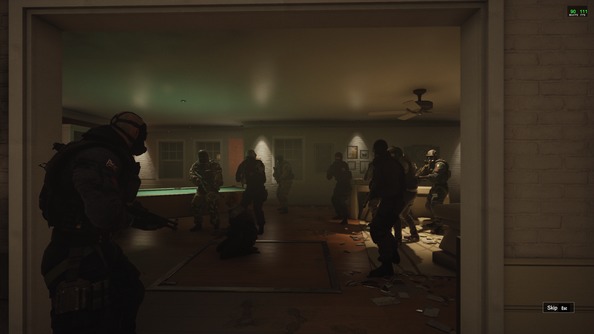
Being completely honest, the differences between Siege’s ultra and very high presets are minimal to my eyes. However the fps difference is sizeable: I averaged 129fps, a pretty massive gain. The major differences are in LOD, shading and texture filtering, the former two down from ultra to very high and medium respectively, while the latter’s now scaled down from x16 to x8. However the effect on video memory is miniscule: 2900MB to 2896MB. I suspect the sweet spot for most systems (particularly those running a GTX 970 or R9 390) lies between ultra and high, so experiment with the two and run the benchmark a few times to lock down your optimal settings. If your system’s still struggling with the demands being placed upon it here though, let’s drop things down to ‘high’:
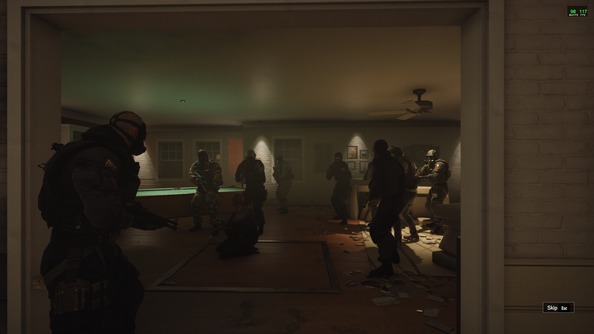
It’s here that we can start to see the overall fidelity drop, but not by much. The high preset let my GTX 980 ti produce an average frame rate of 139, but as with higher settings it did also include a very brief dip down into the high twenties -we’re talking single frames here – when an explosion went off. The saving on VRAM takes the load down to 2500MB, and reflections and textures are pared down to high and medium respectively. As with its engine stablemate AssCreed Syndicate, it’s the lowering of texture resolution that really makes an impact on image quality. Avoid lowering this setting if you’re tweaking the sliders – turn down AA, shaders and reflections first. If you’re still having fps issues, the good news is things don’t look much worse down at medium settings:
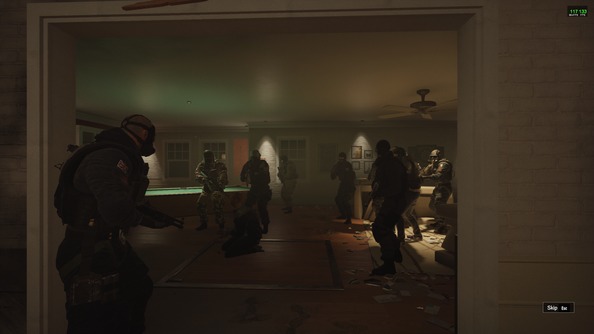
Using this preset my machine produced an average of 151fps, but that momentary dip to 29fps during an explosion still rears its head. Meanwhile, the highest reported frame rate has gone loopy, at 277. A lot of fidelity has been lost now since those halcyon ultra days – the shadows don’t look very convincing anymore, character and object polygon counts have lowered, and the textures on that operative on the left are much blurrier. However, looking at the image holistically it’s still an attractive scene. Let’s face it, we’re a long way from CS:GO and we haven’t needed a monster system to get there. But what if you’re still struggling? Can you bear to look the ‘low’ preset in the eye? Damn straight you can:
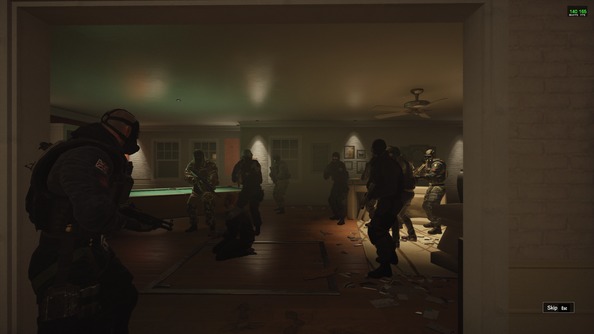
This is the worst the game looks. Not bad, is it? Shadows, objects and textures have all gone on a bit of a journey as we’ve scaled down from ultra, but the clean aesthetic and filmic lighting remain. Plus, the frame rate on my test machine is now 163.7, almost 1:1 with that insane 165Hz refresh rate. The bottom line here is that if you need to prioritize frame rate above all else, you’ll still end up with a handsome-looking game once you’ve cut away the fat. VRAM usage at this preset is a tidy 1153MB, which means you should be able to get strong, consistent performances out of a 2GB card.
However there are some niggles; some telltale signs perhaps of Siege’s cross-platform development. Firstly, texture pop-in – and in some cases object pop-in – is a real problem. It’s especially apparent when transitioning from outdoor to indoor environments, as can be observed when running the benchmark and keeping an eye on the bookshelf visible from the front door right at the start of the scene. The issue doesn’t seem to be alleviated by any graphics menu tweaking, either.
My second beef, if I’m permitted to go off on a side note momentarily, is that an internet connection’s required to do absolutely anything in the game. I lost connection during the benchmark, and was kicked out. All I can say is that Siege had better be utterly unblemished by cheaters to justify such stringent always-online measures.
In happier news, mouse and keyboard controls feel good, with no perceptible sensitivity disparity between x and y axis as in Fallout 4, and really responsive mouse input even at lower frame rates. Early impressions suggest Ubisoft Montreal have created an environment that e-sports players can take their talents, and a hardcore community can grow without having to write their own .ini files first.
Verdict: Passed
Can you run it? Check the Rainbow Six Siege system requirements 2021 on PCGameBenchmark.
